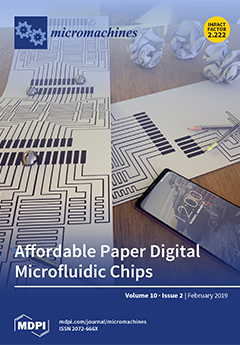Molybdenum oxide (MoO
3) and Fe,Co-codoped MoO
3 thin films obtained by spray pyrolysis have been in-depth investigated to understand the effect of Co and Fe codoping on MoO
3 thin films. The effect of Fe and Co on the structural, morphological
[...] Read more.
Molybdenum oxide (MoO
3) and Fe,Co-codoped MoO
3 thin films obtained by spray pyrolysis have been in-depth investigated to understand the effect of Co and Fe codoping on MoO
3 thin films. The effect of Fe and Co on the structural, morphological and optical properties of MoO
3 thin films have been studied using X-ray diffraction (XRD), scanning electron microscopy (SEM), transmission electron microscopy (TEM) and energy-dispersive X-ray analysis (EDAX), optical and photoluminescence (PL) spectroscopy, and electropyroelectric methods. The XRD patterns demonstrated the formation of orthorhombic α-MoO
3 by spray pyrolysis. SEM characterization has shown an increase in roughness of MoO
3 thin films by Fe and Co doping. Optical reflectance and transmittance measurements have shown an increase in optical band gap with the increase in Fe and Co contents. Thermal conductivity and thermal diffusivity of Fe,Co-doped MoO
3 were 24.10–25.86 Wm
−1K
−1 and 3.80 × 10
−6–5.15 × 10
−6 m
2s
−1, respectively. MoO
3 thin films have shown PL emission. Doping MoO
3 with Fe and Co increases emission in the visible range due to an increase number of chemisorbed oxygen atoms. The photodegradation of an aqueous solution of methylene blue (MB) depended on the content of the codoping elements (Fe,Co). The results showed that a degradation efficiency of 90% was observed after 60 min for MoO
3: Fe 2%-Co 1%, while the degradation efficiency was about 35% for the undoped MoO
3 thin film.
Full article






